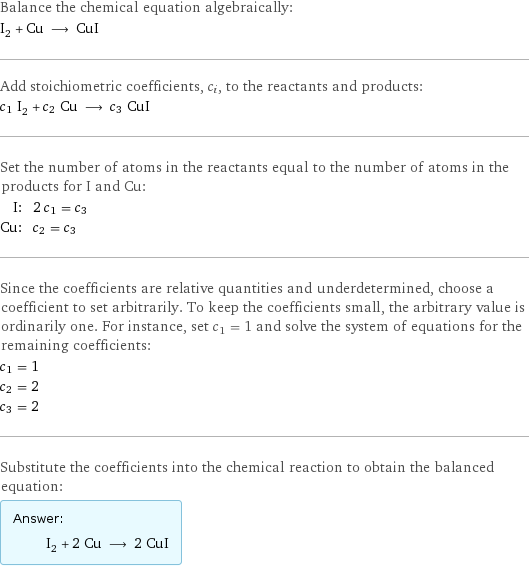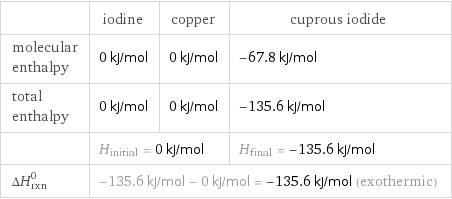Input interpretation

I_2 iodine + Cu copper ⟶ CuI cuprous iodide
Balanced equation

Balance the chemical equation algebraically: I_2 + Cu ⟶ CuI Add stoichiometric coefficients, c_i, to the reactants and products: c_1 I_2 + c_2 Cu ⟶ c_3 CuI Set the number of atoms in the reactants equal to the number of atoms in the products for I and Cu: I: | 2 c_1 = c_3 Cu: | c_2 = c_3 Since the coefficients are relative quantities and underdetermined, choose a coefficient to set arbitrarily. To keep the coefficients small, the arbitrary value is ordinarily one. For instance, set c_1 = 1 and solve the system of equations for the remaining coefficients: c_1 = 1 c_2 = 2 c_3 = 2 Substitute the coefficients into the chemical reaction to obtain the balanced equation: Answer: | | I_2 + 2 Cu ⟶ 2 CuI
Structures

+ ⟶
Names

iodine + copper ⟶ cuprous iodide
Reaction thermodynamics
Enthalpy

| iodine | copper | cuprous iodide molecular enthalpy | 0 kJ/mol | 0 kJ/mol | -67.8 kJ/mol total enthalpy | 0 kJ/mol | 0 kJ/mol | -135.6 kJ/mol | H_initial = 0 kJ/mol | | H_final = -135.6 kJ/mol ΔH_rxn^0 | -135.6 kJ/mol - 0 kJ/mol = -135.6 kJ/mol (exothermic) | |
Equilibrium constant
![Construct the equilibrium constant, K, expression for: I_2 + Cu ⟶ CuI Plan: • Balance the chemical equation. • Determine the stoichiometric numbers. • Assemble the activity expression for each chemical species. • Use the activity expressions to build the equilibrium constant expression. Write the balanced chemical equation: I_2 + 2 Cu ⟶ 2 CuI Assign stoichiometric numbers, ν_i, using the stoichiometric coefficients, c_i, from the balanced chemical equation in the following manner: ν_i = -c_i for reactants and ν_i = c_i for products: chemical species | c_i | ν_i I_2 | 1 | -1 Cu | 2 | -2 CuI | 2 | 2 Assemble the activity expressions accounting for the state of matter and ν_i: chemical species | c_i | ν_i | activity expression I_2 | 1 | -1 | ([I2])^(-1) Cu | 2 | -2 | ([Cu])^(-2) CuI | 2 | 2 | ([CuI])^2 The equilibrium constant symbol in the concentration basis is: K_c Mulitply the activity expressions to arrive at the K_c expression: Answer: | | K_c = ([I2])^(-1) ([Cu])^(-2) ([CuI])^2 = ([CuI])^2/([I2] ([Cu])^2)](../image_source/b5389f76a7c0dc751e85d23b121a80ab.png)
Construct the equilibrium constant, K, expression for: I_2 + Cu ⟶ CuI Plan: • Balance the chemical equation. • Determine the stoichiometric numbers. • Assemble the activity expression for each chemical species. • Use the activity expressions to build the equilibrium constant expression. Write the balanced chemical equation: I_2 + 2 Cu ⟶ 2 CuI Assign stoichiometric numbers, ν_i, using the stoichiometric coefficients, c_i, from the balanced chemical equation in the following manner: ν_i = -c_i for reactants and ν_i = c_i for products: chemical species | c_i | ν_i I_2 | 1 | -1 Cu | 2 | -2 CuI | 2 | 2 Assemble the activity expressions accounting for the state of matter and ν_i: chemical species | c_i | ν_i | activity expression I_2 | 1 | -1 | ([I2])^(-1) Cu | 2 | -2 | ([Cu])^(-2) CuI | 2 | 2 | ([CuI])^2 The equilibrium constant symbol in the concentration basis is: K_c Mulitply the activity expressions to arrive at the K_c expression: Answer: | | K_c = ([I2])^(-1) ([Cu])^(-2) ([CuI])^2 = ([CuI])^2/([I2] ([Cu])^2)
Rate of reaction
![Construct the rate of reaction expression for: I_2 + Cu ⟶ CuI Plan: • Balance the chemical equation. • Determine the stoichiometric numbers. • Assemble the rate term for each chemical species. • Write the rate of reaction expression. Write the balanced chemical equation: I_2 + 2 Cu ⟶ 2 CuI Assign stoichiometric numbers, ν_i, using the stoichiometric coefficients, c_i, from the balanced chemical equation in the following manner: ν_i = -c_i for reactants and ν_i = c_i for products: chemical species | c_i | ν_i I_2 | 1 | -1 Cu | 2 | -2 CuI | 2 | 2 The rate term for each chemical species, B_i, is 1/ν_i(Δ[B_i])/(Δt) where [B_i] is the amount concentration and t is time: chemical species | c_i | ν_i | rate term I_2 | 1 | -1 | -(Δ[I2])/(Δt) Cu | 2 | -2 | -1/2 (Δ[Cu])/(Δt) CuI | 2 | 2 | 1/2 (Δ[CuI])/(Δt) (for infinitesimal rate of change, replace Δ with d) Set the rate terms equal to each other to arrive at the rate expression: Answer: | | rate = -(Δ[I2])/(Δt) = -1/2 (Δ[Cu])/(Δt) = 1/2 (Δ[CuI])/(Δt) (assuming constant volume and no accumulation of intermediates or side products)](../image_source/bcda289c346fbafeec3e3f759dec5db4.png)
Construct the rate of reaction expression for: I_2 + Cu ⟶ CuI Plan: • Balance the chemical equation. • Determine the stoichiometric numbers. • Assemble the rate term for each chemical species. • Write the rate of reaction expression. Write the balanced chemical equation: I_2 + 2 Cu ⟶ 2 CuI Assign stoichiometric numbers, ν_i, using the stoichiometric coefficients, c_i, from the balanced chemical equation in the following manner: ν_i = -c_i for reactants and ν_i = c_i for products: chemical species | c_i | ν_i I_2 | 1 | -1 Cu | 2 | -2 CuI | 2 | 2 The rate term for each chemical species, B_i, is 1/ν_i(Δ[B_i])/(Δt) where [B_i] is the amount concentration and t is time: chemical species | c_i | ν_i | rate term I_2 | 1 | -1 | -(Δ[I2])/(Δt) Cu | 2 | -2 | -1/2 (Δ[Cu])/(Δt) CuI | 2 | 2 | 1/2 (Δ[CuI])/(Δt) (for infinitesimal rate of change, replace Δ with d) Set the rate terms equal to each other to arrive at the rate expression: Answer: | | rate = -(Δ[I2])/(Δt) = -1/2 (Δ[Cu])/(Δt) = 1/2 (Δ[CuI])/(Δt) (assuming constant volume and no accumulation of intermediates or side products)
Chemical names and formulas

| iodine | copper | cuprous iodide formula | I_2 | Cu | CuI name | iodine | copper | cuprous iodide IUPAC name | molecular iodine | copper | cuprous iodide
Substance properties

| iodine | copper | cuprous iodide molar mass | 253.80894 g/mol | 63.546 g/mol | 190.45 g/mol phase | solid (at STP) | solid (at STP) | solid (at STP) melting point | 113 °C | 1083 °C | 605 °C boiling point | 184 °C | 2567 °C | 1290 °C density | 4.94 g/cm^3 | 8.96 g/cm^3 | 5.62 g/cm^3 solubility in water | | insoluble | insoluble dynamic viscosity | 0.00227 Pa s (at 116 °C) | | odor | | odorless |
Units
